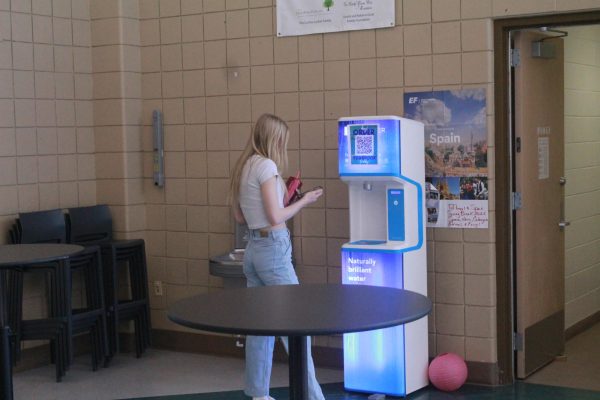Tiny, Harmful, and Absolutely Everywhere
Microplastics threaten human and environmental health
All of the plastics shown within this photo will one day become microplastics, polluting the environment, oceans, or even your digestive system.
People are surrounded by tiny bits of plastic hidden within their everyday life. These plastic bits may be small, but they pose a large threat to health and the environment. They are called microplastics.
“Microplastics are basically residue of other plastic trash,” Environmental Science teacher Jeff Colborn said.
These tiny bits of plastic come in two categories: primary and secondary. Primary microplastics are plastics that were already small to begin with. Things such as microfibers from clothing or plastic pellets called nurdles, that are melted to make other forms of plastic. The secondary microplastics are the result of larger plastics getting broken down, such as water bottles or wrappers.
“Plastic is literally everywhere,” Colborn said. “It’s a pretty serious pollution problem.”
Plastic surrounds everyone and people use it all the time. Bottles, straws, lids, bags, and wrappers are just a few examples. Humans are constantly manufacturing plastic for everything. The problem is that plastic is made to last for more than one lifetime, but it is marketed to be thrown away after one use. Plastic doesn’t biodegrade because it was made to last so long, so over time it breaks down into small pieces instead.
“The problem is people don’t know what [microplastics] are,” Biology Teacher, Christine Stricker, said, “and they don’t know about the different kinds of products we use that have microplastics in them.”
Microplastics are all over the oceans and the environment, but they are also in many different products created by humans. Eventually, these plastic bits make their way into the food chain. And they aren’t the only things humans are ingesting.
“There are reasons to believe that we are all going to end up with measurable amounts of plastic pollution in our systems,” Colborn said, “because all our ecosystems are contaminated.”
The oceans are filled with these tiny microplastics, which leads to fish ingesting the plastic. When they do, they aren’t able to digest it. So instead, it gets stored within their body. If another animal eats the fish, the plastic will stay undigested within the predator’s body. Throughout the world, it is estimated that humans consume 23 million tons of fish per year. When people consume the fish, they also consume the plastic that has been stored within the fish’s body.
“Everything comes full circle and we use a lot of the environmental services for ourselves,” Keep Conifer Green member, Allie Westfall, said.
But it’s not just the living animals that carry microplastics. Almost every kind of food comes in some form of plastic packaging, so microplastics could be consumed with anything They could be ingested in foods like fruit, vegetables, or snacks. Microplastics can even be in the air and could be inhaled with every breath.
Of course, they can be in drinks too. Keurigs are pots used to quickly boil water to make coffee or other hot beverages, but studies have shown that when heated, the plastic that Keurigs are made of can have harmful effects. The plastic chemicals can act like estrogen and negatively affect hormones within the human body.
At CHS, there are about 17 Keurigs distributed throughout the rooms. Everywhere you go, there will always be microplastics. It doesn’t matter where, it could be at home, in a store, at a restaurant, or at school.
“My biggest concern about microplastics is the effect it could have on human health,” Water Treatment Engineer, Mike Schmitt, said.
The health issues caused by Keurigs aren’t the only problems that microplastics can create. It has been shown that exposure to microplastics can cause toxicity throughout the human body. Sometimes there can also be metabolic disturbances, neurotoxicity, and increased cancer risk in humans. They can even release substances into someone’s blood or organs.
Of course, humans aren’t the only things affected by microplastics. The environment takes a hard hit from the microplastics, too. Microplastics pollute the oceans and waterways and can affect many food chains. Also, aquatic life, such as sea turtles, can be damaged by microplastics. Their digestive tracts can be blocked, which reduces their urge to eat, and alters feeding behavior. This can cause many to starve and die.
“I think the first step towards fixing this problem is to stop dumping microplastic waste into the waterways and ocean,” Schmitt said.
Of course, while it’s important to work on cleaning up the microplastics that are already in the environment, cutting down on the amount of plastic dumped in the water will stop the problem from continuing. By keeping the oceans and waterways clean, aquatic life won’t die and the seafood humans consume won’t be contaminated with microplastics. there are also solutions besides keeping plastic out of the water.
“I think we need to focus more on our recycling,” Westfall said.
Many plastics don’t actually get recycled and end up littering the land or oceans, but if done right, recycling could make a difference in the amount of microplastic that ends up in the environment. Fixing this problem will be difficult, especially due to the lack of awareness on all age levels. But if people work on using less plastic, doing more recycling, and helping others become aware of the issue, the problem will be much easier to fix. Anyone looking to help with this problem can also find more information and environmental facts on Keep Conifer Green Club’s Instagram.
“What we need to do is change our attitude toward this stuff as a society,” Colborn said, “and then things can start to change.”














